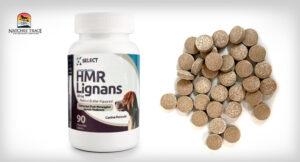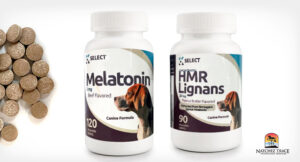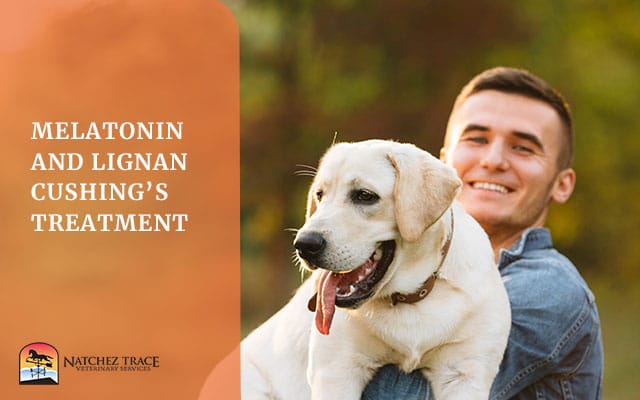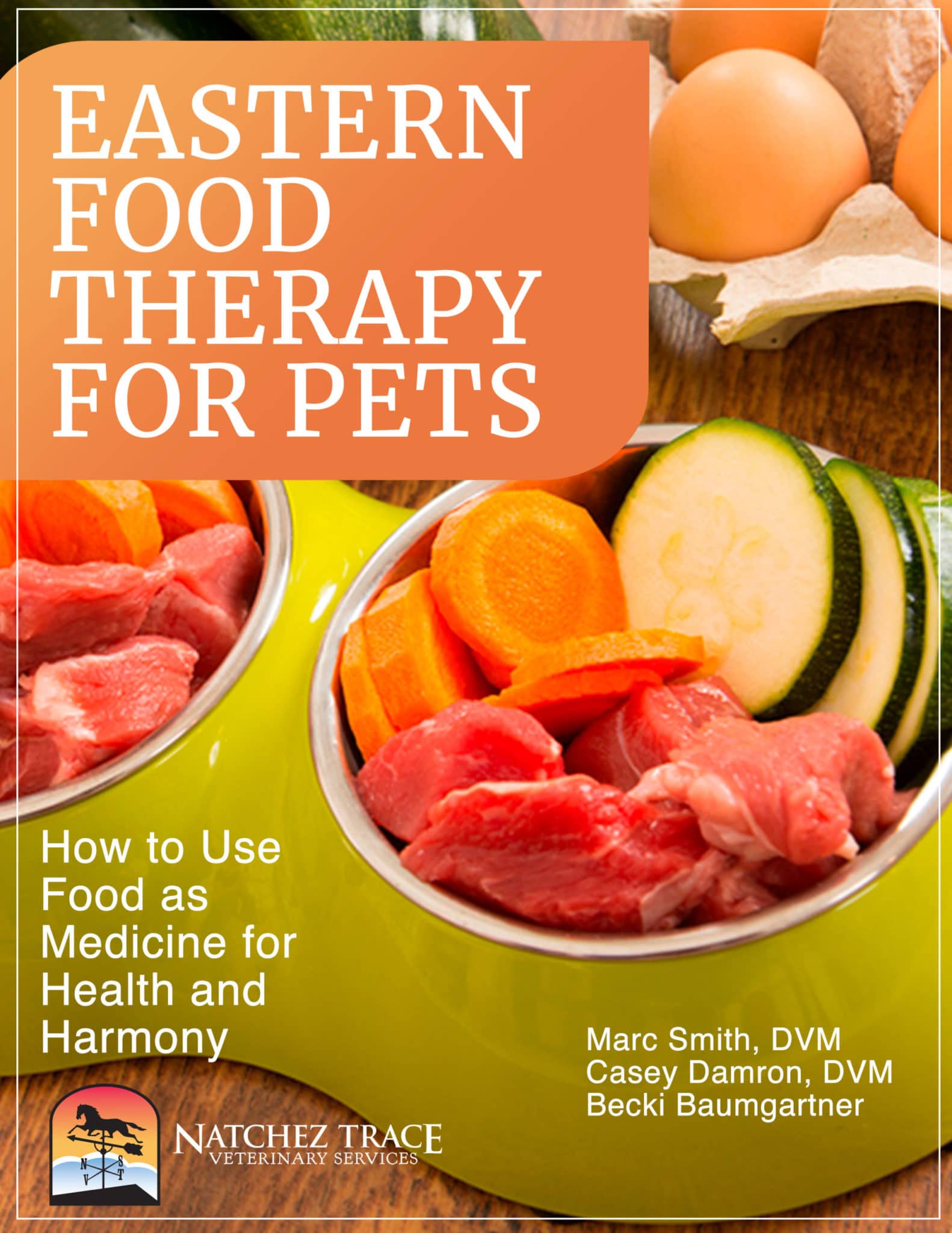Lignans for dogs are a natural way to support the well-being of dogs who suffer from Cushing’s disease.
This disease happens when there is an overproduction of cortisol from the adrenal glands. An unregulated level of this hormone (overproduction), can lead to various symptoms such as:
- Increased thirst

- Increased appetite
- Hair loss
- Compromised immune system
But where exactly do lignans for dogs come from?
Lignans are compounds found in plants. These compounds help regulate hormone levels. Hence, they inhibit the overproduction of cortisol in dogs with Cushing’s disease. More than that, lignans also help regulate other enzymes in the adrenal glands, dramatically reducing the symptoms of Cushing’s disease.
Similarly, Melatonin is another natural supplement that can help combat Cushing’s disease in dogs. If you’ve noticed, sleep-deprived people often buy melatonin. The number one reason for this is because it induces sleepiness.
Melatonin is a hormone that guards the sleep-wake cycle and regulates cortisol production. By adding melatonin to your fur baby’s supplement regimen, his sleep may improve, and his cortisol level may decrease.
This article will discuss what you need to know about melatonin and lignans for dogs with Cushing’s disease for a holistic treatment plan to improve your dog’s overall health.
Lignans For Dogs With Cushing’s Disease
 Lignans for dogs are an excellent choice for easing the symptoms of Cushing’s disease.
Lignans for dogs are an excellent choice for easing the symptoms of Cushing’s disease.
When ingested, the body converts plant lignans to other lignans, such as enterolactone.
Enterolactone is a major endogenous-mammalian lignan formed by the action of intestinal bacteria on plant lignans when ingested and acts as a phytoestrogen in the body.
There are two kinds of lignans for dogs, SDG (secoisolariciresinol diglucoside) lignans extracted from flax hulls and 7-HMR (7-hydroxymatairesinol) lignans extracted from the Norwegian spruce tree.
The main difference between the two types of lignans for dogs are:
- In the SDG flax hull lignan, cleavage of sugar chains must occur by the gastrointestinal bacteria before the enterolactone is formed.
- In the HMR Norwegian Spruce tree lignan, conversion to enterolactone by gastrointestinal bacteria is immediate upon ingestion.
Reports show that HMR lignan is completely and quickly absorbed from the gastrointestinal tract, while the SDG lignan is not entirely absorbed.
This indicates that enterolactone formed by HMR lignans is absorbed better and more quickly than the SDG flax hull lignan, allowing for lower dosages.
According to the University of Tennessee College of Veterinary Medicine, the suggested doses are:
- SDG flax hull lignans – 1mg per lb of body weight
- HMR lignans – total doses of 10 mg – 40 mg daily should be adequate for small to large dogs
Melatonin For Dogs With Cushing’s Disease
In addition to lignans for dogs, we recommend melatonin supplements. Melatonin is a hormone the pineal gland produces that helps regulate hormones and the body’s circadian rhythm.
It is used in veterinary medicine as a natural treatment for coat loss in dogs, cats, and ferrets.
Researchers are not exactly sure how melatonin helps thicken and regrow fur.
Some researchers think it may be the relationship between melatonin, sunlight, and the body’s circadian rhythm.
 Others feel that melatonin’s antioxidant properties help promote hair growth.
Others feel that melatonin’s antioxidant properties help promote hair growth.
Melatonin has also been shown to help a pet gain back weight after surgery, stress, or illness and help with anxiety, insomnia, and noise phobias.
Research recommends not exceeding a melatonin dosage of 3 to 6 mg every 8 to 12 hours.
A general guideline for dosing melatonin is:
- Dogs under 10 lbs – 1 mg of melatonin every 12 hours (also for those who want to give their dogs very low doses of melatonin)
- Dogs under 30 lbs – 3 mg of melatonin every 12 hours
- Dogs over 30 lbs – 6 mg of melatonin every 12 hours
- Note: Research recommends not exceeding a melatonin dosage of 3 to 6 mg every 8 to 12 hours.
- Note: Make sure you read the label and give your dog supplements containing melatonin only. Colorings and additives may be toxic to your dog.
Melatonin makes some dogs sleepy. If melatonin makes your dog excessively tired, only give it at night.
If you plan to give your dog melatonin once daily, you should dose it in the evening.
Melatonin is also available in implant form. You can learn more about melatonin implants at Melatonin Implant Technology.
Please remember, though, that every pet is different, and it is always best to consult your veterinarian for the best possible dosage for your pet’s situation.
Adjustments may be needed for particular health situations and/or medications.
See Dr. Smith’s Recommended Melatonin for Dogs
Melatonin And Lignans For Dogs:
Before rushing to your vet clinic to buy melatonin or lignans for dogs, knowing the side effects, warnings, and interactions is vital.
Let’s go over them one by one.
Lignans for Dogs Side Effects, Warnings, and Interactions
 If you use SDG flax hull lignans, stool frequency may increase, and occasional diarrhea may occur because of its fiber component.
If you use SDG flax hull lignans, stool frequency may increase, and occasional diarrhea may occur because of its fiber component.
HMR Norwegian Spruce lignans contain very little fiber, so using this type of lignan should not cause issues with stool frequency and diarrhea.
According to the University of Tennessee College of Veterinary Medicine, no adverse effects from using SDG flax lignan have been reported based on their suggested daily dose of 1mg/lb of body weight.
They report limited feedback on the use of HMR lignan, citing only human studies showing that single doses of 1,200 mg did not cause any side effects in humans and that a 13-week study in rodents at a dose of 2,600mg/kg of HMR lignan did not cause any toxic effects.
Melatonin for Dogs Side Effects, Warnings, and Interactions
Other than Lignans for dogs, there have been no reports of significant side effects of melatonin use in dogs.
 There have been a few reports of minor gastric upset and sleepiness. Melatonin has been shown to slightly alter the time an un-spayed female comes into heat.
There have been a few reports of minor gastric upset and sleepiness. Melatonin has been shown to slightly alter the time an un-spayed female comes into heat.
Melatonin may also interact with corticosteroids and some internal body processes.
Melatonin is not recommended for use in breeding dogs because it has been shown sometimes to alter mating desire and when a dog comes into heat.
It is imperative not to exceed the recommended amount of melatonin.
Be very careful when choosing your melatonin product. Many melatonin products sold for humans are much stronger than the recommended amount for dogs.
Signs of overdosage include diarrhea, vomiting, high blood pressure, incoordination, and even possibly seizures.
Note: Read the label and give your dog supplements containing melatonin only. Colorings and additives may be toxic to your dog.
We recommend getting melatonin and lignans at TCVM Pet Supply, as the products are top quality, and dosing instructions for your dog’s weight are listed on the label.
 Note: It is always best to consult your veterinarian before concluding that your pet has a particular ailment. In the case of Canine Alopecia, you should ensure that your veterinarian rules out thyroid disease, Cushing’s disease, parasites, mites, and certain bacteria. All of these can cause symptoms similar to Canine Seasonal Alopecia. To test for thyroid or Cushing’s disease, your veterinarian will need to perform a blood test; a skin sample may need to be taken for parasites, mites, and certain bacteria.
Note: It is always best to consult your veterinarian before concluding that your pet has a particular ailment. In the case of Canine Alopecia, you should ensure that your veterinarian rules out thyroid disease, Cushing’s disease, parasites, mites, and certain bacteria. All of these can cause symptoms similar to Canine Seasonal Alopecia. To test for thyroid or Cushing’s disease, your veterinarian will need to perform a blood test; a skin sample may need to be taken for parasites, mites, and certain bacteria.
Sources:
- Geneva’s Pomeranians: Alopecia
- Lingans (Phytonutrients)
- Melatonin Therapy for Canine Alopecia by Manin Paradis
- Natural Remedy for Alopecia (Baldness) In Pets
- Seasonal Flank Alopecia
- University of Tennessee Department of Endocrinology
- What is Seasonal Alopecia?







